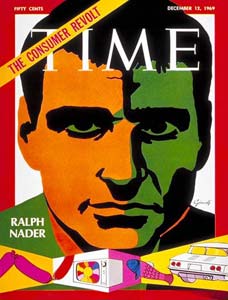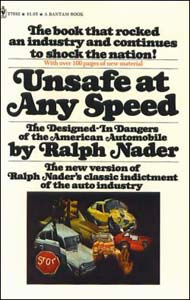
1965 – Ralph Nader publishes “Unsafe at any Speed.” The book criticizes the auto industry for failing to make cars safer to drive.
In 1965, a little-known book criticizing the Detroit automakers would receive widespread attention for its accusations after General Motors, the largest company in the country, was found to have investigated its author.
Ralph Nader was not a well-known person in the United States in the early 1960s. A lawyer, Nader had written an article in The Nation in October 1963, noting that some cars seemed to be more accident-prone than others and that the safety of a car was a function of how the car was built as well as how it was driven. “Slaughter on the highways has been a perennial phenomenon for nearly half a century, and still an industry is permitted to produce, unhindered, vehicles full of accidents and tragedies waiting to happen,” wrote Nader.
The article was virtually ignored, and the auto industry was successful in thwarting attempts to force it to build safer vehicles for nearly a decade. In the spring of 1965, a Senate subcommittee led by Connecticut Sen. Abraham Ribicoff began investigating highway safety. Nader, who was an advisor to the subcommittee, testified about a Cornell University study that showed a relationship between the design of a car and fatal accidents.
The first time Nader appeared in the New York Times, however, was on Nov. 30, 1965 , the day his book “Unsafe at Any Speed” was published, criticizing the safety of several cars, particularly GM’s Corvair. In an article on p. 68, Nader blasted the auto industry, the tire producers, the National Safety Council and the American Automobile Association for ignoring safety problems. The second paragraph of the article read, “Ralph Nader, a Washington lawyer, says that auto safety takes a back seat to styling, comfort, speed, power and the desire of auto makers to cut costs.” The story later stated, “Mr. Nader charges that the President’s Committee for Traffic Safety is little more than a private-interest group running a public agency that speaks with the authority of the President.”

The industry reacted swiftly. The next day, the Times ran an article on p. 37 in which the automobile industry denied Nader’s charges. Both the Nov. 30 and Dec. 1 articles mentioned his book, however. In the Nov. 30 article, the book was mentioned in the sixth paragraph, but in the Dec. 1 article where the car companies denied ignoring safety, it was mentioned in the third paragraph.
Interest in Nader’s accusations and his book would have likely died if not for what General Motors did next. The company hired private investigators to pry into the life of its adversary. When details of its investigation into Nader became public, Ribicoff and others were outraged. On March 9, 1966 , the Times reported that two senators – Ribicoff and Gaylord Nelson from Wisconsin – called for a Justice Department investigation into the harassment. “No citizen of this country should be focused to endure the kind of clumsy harassment to which Mr. Nader has apparently been subjected since the publication of his book,” said Ribicoff. “Anonymous phone calls in the middle of the night have no place in a free society.”
A day later, General Motors admitted that it had investigated Nader. By this time, the Times had moved the story to the front page of the paper. And with GM backtracking, the media continued to cover the story aggressively. On March 23, the apology to Nader from GM prominently written about on page one of the Times, along with Nader’s picture, as Ribicoff had held a hearing the day before on GM’s spying.